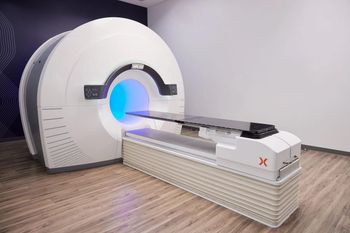Emerging cone-beam breast CT research suggests asymmetric nipple-areolar complex (NAC) enhancement and tumor-nipple enhancement within 2 cm of the NAC are associated with a significantly higher likelihood of NAC involvement in early-stage breast cancer.
For the retrospective study, recently published in European Radiology, researchers assessed the use of contrast-enhanced cone-beam breast computed tomography (CE-CBBCT) in 91 women with breast cancer and pathological NAC involvement and 91 women with breast cancer and no pathological NAC involvement. The reviewing radiologists had three and four years of experience with CBBCT, according to the study.
The study authors noted a 96.7 sensitivity rate, 70.33 percent specificity and an 83.52 percent accuracy rate for CE-CBBCT in predicting NAC involvement. The researchers also noted a 95.52 percent negative predictive value (NPV) and a 76.52 percent positive predictive value (PPV) for the use of CE-CBBCT in predicting NAC involvement.
“These data indicate that CBBCT is a reliable imaging approach for predicting NAC involvement before surgery,” wrote lead study author Jie Huang, M.D., who is affiliated with the Department of Radiology at the State Key Laboratory of Oncology and Sun Yat-Sen University Cancer Center in Guangzhou, China, and colleagues.
The researchers also found that CE-CBBCT findings of asymmetric NAC enhancement and tumor-nipple enhancement within 2 cm of the NAC were associated with five times and four times higher likelihood, respectively, of NAC involvement in breast cancer.
“In particular, when asymmetric NAC enhancement and TNE extending to the NAC occurred simultaneously, the PPV was highest (82.35%),” pointed out Huang and colleagues.
Three Key Takeaways
1. High sensitivity and predictive accuracy. Contrast-enhanced cone-beam breast CT (CE-CBBCT) demonstrated a 96.7 percent sensitivity, 83.5 percent accuracy, and 95.5 percent negative predictive value in detecting nipple-areolar complex (NAC) involvement in breast cancer, indicating strong reliability in preoperative assessment.
2. Imaging markers linked to higher NAC involvement. CE-CBBCT findings of asymmetric NAC enhancement and tumor-nipple enhancement within 2 cm of the NAC were associated with 5x and 4x increased likelihood, respectively, of NAC involvement.
3. Potential alternative to MRI with biopsy integration. While CE-CBBCT has slightly lower specificity than MRI, combining CE-CBBCT with CBBCT-guided biopsy may offer a practical and precise approach to guide surgical planning for patients with suspected NAC involvement.
While noting that CE-CBBCT offers comparable accuracy and PPV to magnetic resonance imaging (MRI) for predicting NAC involvement, the researchers acknowledged that CE-CBBCT has less specificity (70.33 percent) than what has been reported for MRI in other studies (ranging between 80 to 90 percent). However, the study authors suggested that the combination of CE-CBBCT and CBBCT-guided biopsy may provide a viable alternative.
“ … Patients who were predicted to have NAC involvement on CBBCT are suggested to undergo preoperative CBBCT-guided biopsy to obtain pathological results of suspicious NAC-involved lesions identified by CBBCT. By combining imaging results with biopsy pathology, clinicians can devise more precise surgical plans for patients,” posited Huang and colleagues.
(Editor’s note: For related content, see “FDA-Cleared AI Software Targets Streak Artifacts in Cone-Beam CT,” “Pre-Operative Breast MRI Predicts Feasibility of Nipple-Sparing Mastectomy” and “Can DWI MRI Offer a Viable Non-Contrast Alternative for Breast Cancer Assessment?”)
Beyond the inherent limitations of a single-center retrospective study, the authors noted that the study only involved two reviewing radiologists and that experience level is a significant consideration with interpreting CE-CBBCT. The researchers also acknowledged higher radiation dosing in CE-CBBCT with mean doses ranging between 11.7 mGy to 16 mGy.





























